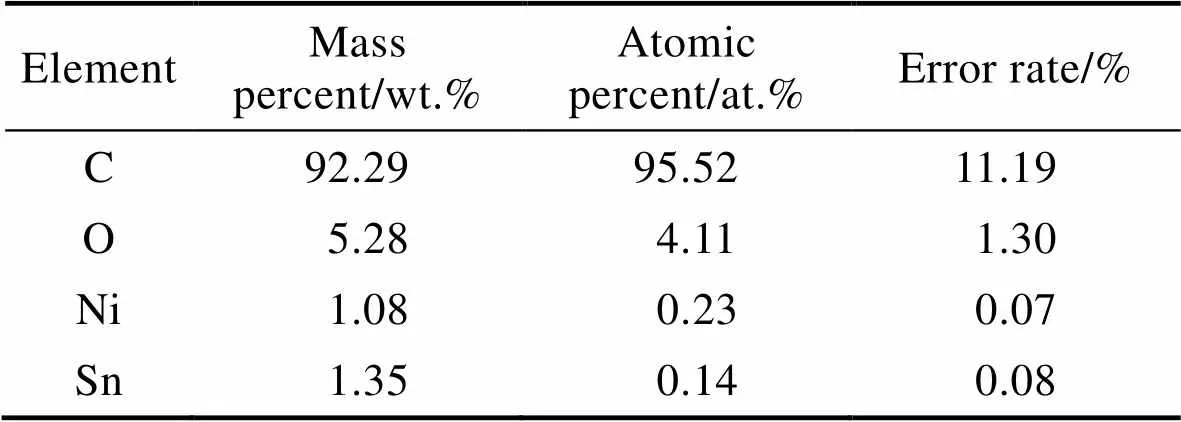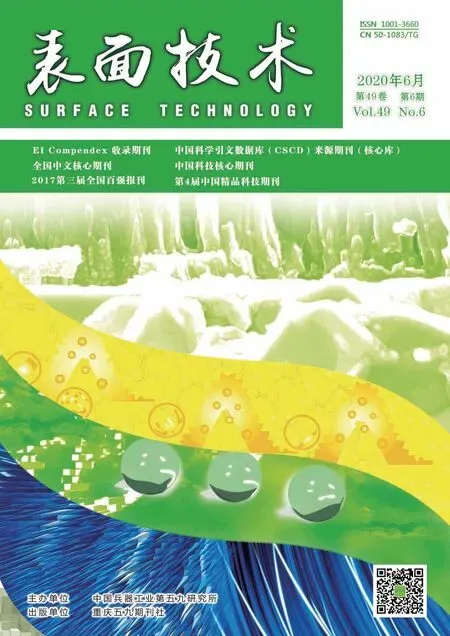火焰法制备螺旋碳纳米纤维及其亲水改性
附青山,张伟,张尚云,何雪梅,陈超,陈建
火焰法制备螺旋碳纳米纤维及其亲水改性
附青山,张伟,张尚云,何雪梅,陈超,陈建
(四川轻化工大学 材料科学与工程学院,四川 自贡 643000)
利用乙醇火焰法制备螺旋碳纳米纤维,并考查不同表面改性方法对螺旋碳纳米纤维亲水性的影响。首先研究不同烧制时间、镍片-火焰距离、SnCl4溶液浓度对制备螺旋碳纳米纤维的影响,然后用水蒸气、聚乙烯吡咯烷酮K30(PVP)溶液以及氢氧化钠-浓硝酸溶液改性螺旋碳纳米纤维。通过扫描电镜、透射电镜、拉曼光谱仪、X射线衍射仪对所制备的螺旋碳纳米纤维进行表征,利用红外光谱分析、X射线光电子能谱分析和沉降实验评价不同改性方法的改性效果。随着镍片-火焰距离的增加,螺旋碳纳米纤维含量增加,均匀度逐渐下降;随着烧制时间的延长,螺旋碳纳米纤维的均匀度先增加后降低;SnCl4的浓度会影响碳纳米纤维的形貌和均匀度。制备均匀的螺旋碳纳米纤维的最佳条件为:73% SnCl4溶液,镍片-火焰距离1.5 cm,烧制9 min。通过红外光谱分析发现,三种改性方法都使螺旋碳纳米纤维表面接上亲水基团。沉降实验表明,PVP溶液和氢氧化钠-浓硝酸改性的螺旋碳纳米纤维在水溶液中静置48 h后的沉降率均为26.7%,而未改性的螺旋碳纳米纤维的沉降率为58.3%。通过乙醇火焰法可以制备出均匀的螺旋碳纳米纤维,其中烧制时间、镍片-火焰距离、SnCl4溶液浓度对制备的螺旋碳纳米纤维的形貌和均匀度影响很大,需要在特定的条件下才能制备出均匀的螺旋碳纳米纤维。通过三种方法对螺旋碳纳米纤维进行改性,发现PVP溶液和氢氧化钠-浓硝酸改性的螺旋碳纳米纤维的表面亲水性更好,其中PVP溶液改性操作简单,且对螺旋碳纳米纤维的形貌没有破坏,对于螺旋碳纳米纤维改性会更有利。
乙醇火焰法;螺旋碳纳米纤维;表面改性;亲水性
螺旋碳纳米纤维形貌类似于DNA[1],除了具有一般直壁碳纳米纤维诸多优异性能外[2-3],其特殊的螺旋结构还具有优良的电磁、光学和力学性能,是一种高强度、高模量、低密度的新型碳材料[4],而且微米级螺旋纤维具有微米孔结构和大的比表面积,从而使其在储能材料[5]、污水处理[6]等诸多领域得到应用[7]。目前,碳纳米纤维的合成方法主要有电弧放电[8]、激光蒸发[9]、化学气相沉积法[10]、火焰法[11]等。其中化学气相沉积法(CVD)是制备螺旋碳纳米纤维最广泛的方法[12-18],但其存在的缺点是耗时长,需要氮气和乙炔等气体,存在安全隐患,成本高,且连续化生产困难。而火焰法可以在大量合成螺旋碳纳米纤维的同时降低制备成本[19]。王兰娟等[20]以乙醇火焰为热源和碳源,在镍基板上制备了螺旋碳纳米纤维。相似的研究有,采用火焰法,以304不锈钢为基板,硝酸镍溶液为催化剂前体,及以316型奥氏体不锈钢为基板,五羰基铁作催化剂,成功地制备了螺旋碳纳米纤维[21-22]。在大规模连续制备螺旋碳纳米纤维的过程中,火焰法具有以下优势:可以自由地选择基板材料,预处理简单,燃料容易获得,储运方便,原材料价格低廉,对环境的污染也非常小,可通过多火焰或大火焰大规模合成螺旋碳纳米纤维,并且设备非常简单,反应在空气气氛中进行,具有广阔的商业前景[23]。
碳纳米纤维表面呈化学惰性,缺乏活性基团,在各种溶剂中的分散性都很低[24]。此外,范德华力、大长径比和高比表面积使碳纳米管之间极易出现团聚和缠绕现象。这些都严重制约了碳纳米管在许多领域中的应用,需要通过表面功能化修饰改善其表面性能,解决其分散性问题[25]。目前对螺旋碳纳米纤维表面改性的方法主要是共价功能化法,但对碳纳米纤维的形貌有很大的破坏,操作复杂,且成本高[25]。
文中通过研究乙醇火焰法制备螺旋碳纳米纤维中的烧制时间、镍片-火焰距离、SnCl4溶液的浓度等参数对形成碳纳米纤维的形貌、直径和均匀度的影响,得到制备均匀螺旋碳纳米纤维的最佳工艺参数。根据目前对螺旋碳纳米纤维改性存在的破坏大、操作复杂等缺点,采用不会对表面产生破坏的PVP K30溶液和水蒸气对螺旋碳纳米纤维进行表面改性,并与常用的氢氧化钾-浓硝酸改性方法进行比较,评价这三种改性方法对螺旋碳纳米纤维表面亲水改性的效果。
1 实验
1.1 火焰法制备螺旋碳纳米纤维
将0.5 mm厚的商用镍片剪成2 cm×2 cm的方片,在丙酮溶液中超声清洗10 min,除去镍片表面的污渍,然后在60 ℃烘干。将SnCl4•5H2O溶于无水乙醇,配成一定浓度(C=57%,73%,80%,85%)的锡盐溶液。取50 μL锡盐溶液滴在烘干的镍片表面,均匀涂覆。涂覆的镍片在90 ℃的大气气氛中烘干待用。如图1所示,将镍片涂有锡盐溶液的一面面向火焰,以镍片到火焰底部的距离定义为镍片-火焰距离D(1、1.5、2 cm),保持不同的设定时间T(3、9、15 min)。烧制后,镍片表面覆盖有黑色物质,通过竹刀刮下、收集。在不同条件下制备的样品命名为CDT。

图1 乙醇火焰法制备螺旋碳纳米纤维
1.2 螺旋碳纳米纤维改性
本研究利用三种方式对烧制的螺旋碳纳米纤维进行表面改性处理:
1)PVP改性(P-CNFs)。将0.1 g螺旋碳纳米纤维加入到25% PVP水溶液(1 g PVP固体加入到3 mL去离子水溶解)中,30 ℃下磁力搅拌24 h。离心收集改性的螺旋碳纳米纤维,用无水乙醇、去离子水依次各清洗3次,在60 ℃真空干燥箱中烘干。
2)水蒸气改性(W-CNFs)。将0.1 g螺旋碳纳米纤维置于水蒸气中熏蒸2 h后,取出,在60 ℃真空干燥箱中烘干。
3)氢氧化钠-浓硝酸改性(AB-CNFs)。取0.1 g螺旋碳纳米纤维,加入10 mL浓度为2 mol/L的氢氧化钠溶液,超声1 h,然后用去离子水离心清洗至中性。将清洗好的螺旋碳纳米纤维干燥后,加入10 mL浓硝酸,超声30 min,然后在60 ℃水浴中磁力搅拌12 h。最后用去离子水将改性的螺旋碳纳米纤维清洗至中性,在60 ℃真空干燥箱中干燥。
1.3 沉降实验
分别称取0.015 g P-CNFs、W-CNFs、AB-CNFs和CNFs放入离心管,各加入5 mL去离子水,超声10 min,形成均匀悬浮液。静置一定时间(0、24、48、72 h)后,在溶液上部1/4处取1 mL混合溶液,加入到质量为1的玻璃瓶中,称量玻璃瓶和混合液的总质量2。然后将含有混合液的玻璃瓶置于60 ℃的真空干燥箱中48 h,直至去离子水被完全烘干,再称量烘干后玻璃瓶(含有被烘干的改性螺旋碳纳米纤维)的质量3。利用公式=3-1计算上部1 mL螺旋碳纳米纤维与水混合物中所含螺旋碳纳米纤维的质量,同时利用公式=[0.030-(3-1)]/0.030× 100%计算螺旋碳纳米纤维的沉降率。质量越大和沉降率越小,表示螺旋碳纳米纤维的沉降越少,在水中分散稳定性越好,改性效果也越好。
2 结果及分析
不同烧制时间、镍片-火焰距离、SnCl4溶液浓度条件下制备的碳纳米纤维的SEM图(VECA 3SBU,捷克TESAN公司)和TEM图(TEM,JEM-2010)如图2所示。图2a—c表明,随着镍片-火焰距离增加,螺旋碳纳米纤维的比例上升,但距离太近或者太远,均匀度都会下降。原因是镍片-火焰距离太近,碳原子在短时间内沉积到催化剂表面,来不及形成螺旋状结构,导致碳纤维不均匀;此外,镍片距离火焰底部太远,碳原子沉积在基板上的量变少,并且火焰温度下降,导致许多无定形碳的生成。由图2d—f可以发现,随着锡盐溶液浓度的增加,碳纳米纤维的比例逐渐降低,螺旋碳纳米纤维的比例逐渐增加,但均匀度逐渐降低,无定形碳增加。这是由于锡盐溶液的浓度增加,使催化剂团聚成大颗粒,影响碳纳米纤维成长的趋势和形貌,并且要在特定的催化剂颗粒大小时,才能生长出均匀的螺旋碳纳米纤维。这可以从图2j中两根碳纳米纤维的形貌得到印证,由于催化剂(黑色颗粒)的形貌和粒径大小不同,造成碳纳米纤维的形貌有很大差距,这与Y. Gao等[26]的催化剂粒径大小对碳纤维形貌有着显著影响的结论一致。由图2g—i可知,在烧制时间为3 min时,就生成了少量的碳纳米纤维,但沉积的碳原子少,大量碳原子只是颗粒状存在。随烧制时间的增长,螺旋碳纳米纤维的均匀度增加。这是由于更多的碳原子在催化剂上面沉积,在催化剂作用下,生长出螺旋状碳纳米纤维。烧制时间超过最佳时间后,碳纳米纤维均匀度下降。这是由于碳原子沉积太多,导致无定形碳增加。从上述实验结果得出乙醇火焰法制备螺旋碳纳米纤维的最佳工艺参数:采用73%的锡盐溶液,镍片-火焰距离为1.5 cm,烧制时间为9 min。图2j—l为该条件下制备的螺旋碳纳米纤维的大倍率SEM和TEM图片,可以看出,螺旋碳纳米纤维的直径为60~80 nm,螺距为80~100 nm。
图3为螺旋碳纳米纤维的EDS能谱(SEM配套的EDS能谱分析仪),表1为相应的元素含量。结果表明,螺旋碳纳米纤维含有C、O、Ni、Sn四种元素。其中C原子的质量分数达到92.29%,原子数分数达到了95.52%;Ni和Sn元素的质量百分数低于0.3%,原子百分数低于0.1%。说明火焰法在731.59条件下制备的螺旋碳纳米纤维中的碳含量非常高。
图4a是螺旋碳纳米纤维的XRD(DX-2800型,丹东奥龙射线仪器集团有限公司)测试结果,可以发现,火焰法制备的螺旋碳纳米纤维中含有C、SnO2、SnO等物质。结合表1可知,SnO2和SnO的含量很少。在25°和43°左右显示出两个加宽的峰,这是典型的石墨(002)和(100)面的特征[27]。图4b是螺旋碳纳米纤维的拉曼光谱图(Raman,DXR,美国Thermo Scientific公司),可以明显看出D峰(缺陷峰)和G峰(石墨峰)。D峰出现在1327 cm–1附近,是由于晶格振动离开布里渊区中心引起的,是由碳纳米管石墨片中的空位和原子取代引起的缺陷的拉曼模式[28-29];G峰出现在1587 cm–1附近,是由于碳原子的面内振动引起的,对应高对称性和高定向性的石墨结构,这也被认为是CNF的特征信号[30]。值,即D带与G带的相对强度比(D/G),取决于石墨化程度和石墨平面的排列[31],可以用来判定螺旋碳纳米纤维的石墨化程度和缺陷多少。值越低,石墨化程度越高,石墨结晶结构缺陷越少。由拉曼光谱图可得到D/G等于1.5,说明火焰法烧制的螺旋碳纳米纤维的缺陷较多。这是由于无水乙醇烧制螺旋碳纳米纤维的温度相对较低,以及制备螺旋碳纳米纤维时火焰不稳定,导致了很多无序结构的出现。

图2 不同条件下碳纳米纤维的SEM和TEM形貌
表1 螺旋碳纳米纤维元素成分

Tab.1 Element composition of helical carbon nanofiber

图3 螺旋碳纳米纤维的能谱分析
图5a是火焰法制备的螺旋碳纳米纤维的N2吸附-脱附等温线及相应的孔径分布图(3H-2000PM2型,贝士德仪器科技(北京)有限公司),N2吸附-脱附等温线对应Ⅱ型等温线。用DFT法分析得出其平均孔径为8.9581 nm,微孔孔容0.0951,介孔孔容为0.2126,表明其微孔和介孔数量多。比表面积(BET)为223.89 m2/g,高于先前报道的螺旋碳纳料纤维的比表面积105 m2/g[32]和143.51 m2/g[33]。造成其比表面积高的原因是火焰法制得的螺旋碳石墨化程度低,石墨结晶结构缺陷大,这与先前的报道相 似[32-33]。图5b是三种亲水改性后螺旋碳纳米纤维的红外光谱图(FTIR,NICOLET 6700,美国Thermo Scientific公司),在3430、2920、650 cm–1左右都有吸收峰,说明这三种改性方法都使螺旋碳纳米纤维接上O—H和C—H基团,并且P-CNFs和AB-CNFs在1700 cm–1左右出现吸收峰,这是羧基的特征吸收峰,表明碳纳米纤维已经改性接上—COOH基团[34-35]。P-CNFs在1421 cm–1出现的吸收峰为C—N拉伸,这归因于PVP K30对螺旋碳纳米纤维改性产生。红外光谱分析表明,三种改性方法都使螺旋碳纳米纤维表面接上亲水基团,使螺旋碳纳米纤维在水中的分散性得到改善。
三种改性和未改性的CNFs静置24 h后,吸取的1 mL混合溶液如图6a—d所示。其中P-CNFs、AB-CNFs和CNFs与水的混合液均匀,看不到分层现象,W-CNFs与水的混合溶液澄清,表明W-CNFs基本都已经发生沉降,水蒸气改性效果差。由图6e可知,P-CNFs和AB-CNFs在静置48 h后,还剩余66%的螺旋碳纳米纤维均匀分散在水中,并且沉降率只有26.7%,而CNFs的沉降率为58.3%,说明P-CNFs和AB-CNFs在水中分散的均匀程度好。酸碱改性主要是在螺旋碳纳米纤维表面形成更多的亲水基团,所以在水中的分散效果得到很大改善。PVP K30改性的主要机理是PVP K30的活化基团与螺旋碳纳米纤维表面的活性基团产生强相互作用[36],发生表面接枝改性,提高螺旋碳纳米纤维的表面极性[37],减少螺旋碳纳米纤维的自团聚[38-39],在水溶液中的分散稳定性提高。W-CNFs静置24 h后,基本都沉降在容器底部,说明其在水中的分散效果差。分散效果差的原因可能是水蒸气改性过程中,螺旋碳纳米纤维相互发生了团聚,并且在干燥过程中发现存在团聚现象。在沉降实验时,为了与P-CNFs、AB-CNFs、CNFs实验条件一致,没有对W-CNFs进行充分研磨,所以导致W-CNFs中存在因团聚而形成的较大颗粒,其在水中分散时更容易沉淀。

图6 螺旋碳纳米纤维通过三种方法改性后沉降实验结果
为了评估螺旋碳纳米纤维经PVP K30改性后表面化学状态的变化,利用XPS(赛默飞Escalab 250Xi,赛默飞世尔科技(中国)有限公司)对CNFs和P-CNFs进行了表征,结果如图7所示。由图7a可以观察到,CNFs和P-CNFs都含有的主要元素有C、O和Sn三种,且C元素的峰最强,表明碳元素的含量最高[40]。另外P-CNFs的XPS能谱图中还出现了N1s的峰,说明PVP K30的活化基团与螺旋碳纳米纤维表面的 活性基团发生了相互作用,因此P-CNFs出现了氮元素[41-42]。从N1s能谱区的高分辨率扫描可以看出,拟合的N1s核心能级峰可以分解为以401.20、400.28、399.49、398.09 eV为中心的四个分量,如图7b所示。根据相关文献的报道[43-44],本结果表明:400.28 eV的最强峰对应“吡咯型氮”;398.09 eV的峰对应“吡啶型氮”;399.49 eV的峰对应“石墨型氮”;401.20 eV的最弱峰对应“季铵或石墨氮”。这也进一步说明了PVP K30改性方法在碳纳米纤维表面发生有效接枝改性,并且没有对碳纳米纤维本身的结构造成伤害[42]。

图7 CNFs和P-CNFs的XPS能谱
3 结论
1)实验得出,采用73%的锡盐溶液,镍片距火焰底部1.5 cm处烧制9 min得到的螺旋碳纳米纤维非常均匀。
2)火焰法制备的螺旋碳纳米纤维D峰的强度比G峰的强度高,说明火焰法制备的螺旋碳纳米纤维的缺陷较多,石墨化程度较低。该方法制备的螺旋碳纳米纤维的比表面积比缺陷更少的螺旋碳纳米纤维的比表面积大。
3)三种改性方法都一定程度使螺旋碳纳米纤维接上亲水基团,其中P-CNFs和AB-CNFs可以均匀分散在水中。静置48 h后,上清液里的螺旋碳纳米纤维基本未沉降,比水蒸气改性的分散效果好。AB-CNFs改性后的形貌会被严重破坏,而PVP溶液改性操作简单,且对螺旋碳纳米纤维的形貌没有破坏,对于螺旋碳纳米纤维亲水改性会更有利。
[1] 张东东, 赵东林, 高云雷, 等. 螺旋形碳纤维的制备及其储锂性能[J]. 中国科技论文, 2014, 9(9): 1009-1012. ZHANG Dong-dong, ZHAO Dong-lin, GAO Yun-lei, et al. Preparation and electrochemical performance of coiled carbon fibers for lithium ion battery[J]. Chinese scientific papers, 2014, 9(9): 1009-1012.
[2] SWAIN S K, JENA I. Polymer/carbon nanotube nanocomposites: a novel material[J]. Asian journal of chemistry, 2010, 22(1): 1-15.
[3] SAHOO N G, RANA S, CHO J W, et al. Polymer nanocomposites based on functionalized carbon nanotubes[J]. Progress in polymer science, 2010, 35(7): 837-867.
[4] LU M, LIU W M, GUO X Y, et al. Coiled carbon nanotubes growth via reduced-pressure catalytic chemical vapor deposition[J]. Carbon, 2004, 42(4): 805-811.
[5] LIU Z H, GUO Z Y, REN X X, et al. Coiled spring-like hard carbon as an anode material for llithium-ion batteries[J]. International journal of electrochemical science, 2019, 14 : 3336-3349.
[6] IRENE G D, FELIX L, FRANCISCO A. Carbon nanofibers: A new adsorbent for copper removal from wastewater[J]. Metals, 2018, 8(11): 914.
[7] JAIN X, WANG D, LIU H, et al. Controllable synthesis of carbon coils and growth mechanism for twinning double-helix catalyzed by Ni nanoparticle[J]. Composites: Part B, 2014, 61: 350-357.
[8] LEE C J, LEE T J, PARK J. Carbon nanofibers grown on sodalime glass at 500 ℃ using thermal chemical vapor deposition[J]. Chemical physics letters, 2001, 340(5-6): 413-418.
[9] CHEN G Y, STOLOJAN V, SILVA S R P, et al. Carbon spheres generated in ‘dusty plasmas’[J]. Carbon, 2005, 43(4): 704-708.
[10] HE B H, LI G Y, CHEN L. A facile N doping strategy to prepare mass-produced pyrrolic N-enriched carbon fibers with enhanced lithium storage properties[J]. Electrochimica acta, 2018, 268(1): 283-294.
[11] YUAN L, SAITO K, LI T. Synthesis of multiwalled carbon nanotubes using methane/air diffusion flames[J]. Proceedings of the combustion institute, 2002, 29(1): 1087-1092.
[12] HERNADI K, THIEN-NGA K, FORRO L. Growth and microstructure of catalytically produced coiled carbon nanotubes[J]. The journal physical chemical B, 2001, 105(50): 12464-12468.
[13] KIN T L, LU M, DAVID H. Coiled carbon nanotubes: synthesis and their potential applications in advanced composite structures[J]. Composites part B engineering, 2006, 37(6): 437-448.
[14] DORA F, KLARA H. A review of the properties and CVD synthesis of coiled carbon nanotubes[J]. Materials, 2010, 3(4): 2618-2642.
[15] 聂松, 陈建, 曾宪光, 等. 特殊结构螺旋纳米碳纤维的制备及电化学性能[J]. 化工新型材料, 2017, 45(2): 79-81. NIE Song, CHEN Jian, ZENG Xian-guang, et al. Preparation and electrochemical performance of helical carbon nanofiber with special structure[J]. New chemical materials, 2017, 45(2): 79-81.
[16] 张华知, 张宏, 黄艳, 等. 论螺旋状纳米碳纤维的制备法[J]. 化工管理, 2017(25): 79. ZHANG Hua-zhi, ZHANG Hong, HUANG Yan, et al. Discussion on preparation method of helical nano carbon fiber[J]. Chemical management, 2017(25): 79.
[17] 任娇, 金永中, 陈建, 等. 低温制备螺旋纳米碳纤维的研究[J]. 现代化工, 2017 , 37(11): 102-105. REN Jiao, JIN Yong-zhong, CHEN Jian, et al. Study on preparation of helical carbon nanofibers at low temperature[J]. Modern chemical industry, 2017, 37(11): 102- 105.
[18] FU X, PAN L J, LI D W, et al. Controlled synthesis of carbon nanocoils with selective coil diameters and structures by optimizing the thickness of catalyst film[J]. Carbon, 2015, 93: 361-369.
[19] LIU Y C, SUN B M, DING Z Y. Catalyst assisted synthesis of carbon nanotubes using the V-shaped pyrolysis flame method[J]. Advanced materials research, 2009, 79- 82: 2123-2126.
[20] 王兰娟, 李春忠, 顾锋, 等. 乙醇火焰燃烧制备螺旋碳纳米纤维及结构分析[J]. 无机材料学报, 2008, 23(6): 1179-1183. WANG Lan-juan, LI Chun-zhong, GU Feng, et al. Morphology and structure of carbon nanocoils synthesis via the flame combustion of ethanol[J]. Journal of inorganic materials, 2008, 23(6): 1179-1183.
[21] SUN B M, LIUY C, LI L, et al. Study on synthesis of carbon nanotubes in V-shaped pyrolysis flame by substrate method[J]. Journal of synthetic crystals, 2009, 38: 303-307.
[22] LIU Y C, CHE J T, REN J H. Influence of carbon source for carbon nanotubes synthesis from controllable flame [J]. Advanced materials research, 2014, 1048: 410-413.
[23] GUO Y H, ZHAI G, RU Y, et al. Effect of different catalyst preparation methods on the synthesis of carbon nanotubes with the flame pyrolysis method[J]. Aip advances, 2018, 8(3): 035111.
[24] 徐绍红, 陈月钰, 马国扬, 等. 多壁碳纳米管的亲水性修饰[J]. 新乡学院学报, 2017, 34(12): 31-34. XU Shao-hong, CHEN Yue-yu, MA Guo-yang, et al. Hydrophilic modification of multiwalled carbon nanotubes [J]. Journal of Xinxiang University, 2017, 34(12): 31-34.
[25] 张鹏飞, 李小刚, 罗鲲, 等.多壁碳纳米管亲水性表面修饰的研究[J]. 化工新型材料, 2013, 41(2): 118-119. ZHANG Peng-fei, LI Xiao-gang, LUO Kun, et al. Study on the hydrophilic surface modification of multi-walled carbon nanotubes[J]. New chemical materials, 2013, 41 (2): 118-119.
[26] GAO Y, ADUSUMILLI S P, TURNER J, et al. Factors affecting the growth of carbon nanofibers on titanium substrates and their electrical properties[J]. Journal of nanoscience & nanotechnology, 2012, 12(10): 7777-7787.
[27] 张铀, 杨威, 罗瑞盈, 等. 纳米球形炭的无催化化学气相沉积制备及其机理研究[J]. 新型炭材料, 2016, 31(5): 467-474. ZHANG You, YANG Wei, LUO Rui-ying, et al. Preparation of carbon nanospheres by non-catalytic chemical vapor deposition and their formation mechanism[J]. New carbon materials, 2016, 31(5): 467-474.
[28] OSSWALD S, FLAHAUT E, GOGOTSI Y. In situ Raman spectroscopy study of oxidation of double- and single-wall carbon nanotubes[J]. Chemistry of materials, 2006, 18(6): 1525-1533.
[29] STRANO M S, DYKE C A, USREY M L, et al. Electronic structure control of single-walled carbon nanotube functionalization[J]. Science, 2003, 301(5639): 1519-1522.
[30] KASUYA A, SASAKI Y, SAITO Y, et al. Evidence for size-dependent discrete dispersions in single-wall nanotubes[J]. Physical review letters, 1997, 78(23): 4434-4437.
[31] KIM C, PARK S H, CHOJ I, et al. Raman spectroscopic evaluation of polyacrylonitrile-based carbon nanofibers prepared by electrospinning[J]. Journal of raman spectroscopy volume, 2004, 35(11): 928–933.
[32] 王兰娟, 李春忠, 顾锋, 等. 纯化及活化对螺旋碳纳米纤维形貌及电化学容量的影响[J]. 中国石油大学学报(自然科学版), 2009, 32(2): 155-159. WANG Lan-juan, LI Chun-zhong, GU Feng, et al. Effects of purification and activation on morphology and electrochemical capacity of carbon nanocoils[J]. Journal of China University of Petroleum (Natural science edition), 2009, 32(2): 155-159.
[33] 邵进, 任玉荣, 李国强, 等. 用作锂离子电池负极材料的包碳螺旋结构碳纳米管[J]. 无机材料学报, 2011, 26(6): 631-636. SHAO Jin, REN Yu-rong, LI Guo-qiang, et al. Carbon coated helical carbon nanotubes used as anode materials of Li-ion battery[J]. Journal of inorganic materials, 2011, 26(6): 631-636.
[34] 申长念. 水溶性多壁碳纳米管的制备和表征[J]. 化工中间体, 2012(12): 38-40. SHEN Chang-nian. Preparation and characterization of water-soluble multi-walled carbon nanotubes[J]. Chemical intermediate, 2012(12): 38-40.
[35] 洪日, 王铎, 高从堦. 多壁碳纳米管的酰氯化和氨化改性及其结构表征[J]. 材料导报B: 研究篇, 2011, 25(14): 100-102. HONG Ri, WANG Duo, GAO Cong-jie. Acyl chloride/ amino modification and characterization of multi-wall carbon nanotubes[J]. Materials guide B: Research, 2011, 25(7): 100-102.
[36] 肖莎莎. 可分散性纳米TiO2的制备及其对水性聚氨酯的改性研究[D]. 开封: 河南大学, 2012. XIAO Sha-sha. Study of polyurethane modified by dispersible nano-TiO2[D]. Kaifeng: Henan University, 2012.
[37] 胡磊青, 程军, 王亚丽, 等. PVP 改性PDMS /PAN中空纤维复合膜提升表面亲水性[J]. 浙江大学学报(工学版), 2019, 53(2): 228-233. HU Lei-qing, CHENG Jun, WANG Ya-li, et al. Improvement on surface hydrophily of hollow fiber-supported PDMS gas separation membrane by PVP modification[J]. Journal of Zhejiang University (Engineering science), 2019, 53(2): 228-233.
[38] 潘卉, 肖莎莎, 赵甜, 等. TiO2/PVP纳米微粒改性聚氨酯皮革涂饰剂的研究[J]. 中国皮革, 2012, 41(17): 32-36. PAN Hui, XIAO Sha-sha, ZHAO Tian, et al. Polyurethane leather finishing agent modified by TiO2/PVP Nano- particles[J]. China leather, 2012, 41(17): 32-36.
[39] 陈华, 任晓惠, 罗汉金, 等. 改性纳米零价铁的制备及其去除水中的四环素[J]. 环境工程学报, 2011, 5(4): 767-771. CHEN Hua, REN Xiao-hui, LUO Han-jin, et al. Preparation of modified nanoscale zero-valent iron particles and its application in removal of tetracycline from wastewater[J]. Chinese journal of environmental engineering, 2011, 5(4): 767-771.
[40] 尉立华, 王瑞, 徐磊, 等. 氧等离子处理时间对碳纳米管表面功能化的影响[J]. 化工新型材料, 2016, 44(11): 117-119. YU Li-hua, WANG Rui, XU Lei, et al. Influence of treatment time on the surface functionalzation of multi-walled carbon nanotube[J]. New chemical materials, 2016, 44 (11): 117-119.
[41] CHEN H, LUO H J, LAN Y C, et al. Removal of tetracycline from aqueous solutions using polyvinylpyrrolidone (PVP-K30) modified nanoscale zero valent iron[J]. Journal of hazardous materials, 2011, 192(1): 44-53.
[42] LIU S H, ZHAI J W. Improving the dielectric constant and energy density of poly (vinylidene fluoride) composites induced by surface-modified SrTiO3nanofibers by polyvinylprrolidone[J]. Journal of materials chemistry A, 2015(3): 1511-1517.
[43] CAO B, ZHANG B, JIANG X D, et al. Direct synthesis of high concentration N-doped coiled carbon nanofibers from amine flames and its electrochemical properties[J]. Journal of power sources, 2011, 196(18): 7868-7873.
[44] HE B H, LI G Y, CHEN L, et al. A facile N doping strategy to prepare mass-produced pyrrolic N-enriched carbon fibers with enhanced lithium storage properties[J]. Electrochimica acta, 2018, 278: 106-113.
Preparation of Helical Carbon Nanofibers by Flame Method and Its Hydrophilic Modification
,,,,,
(School of Materials Science and Engineering, Sichuan University of Science & Engineering, Zigong 643000, China)
The work aims to prepare helical carbon nanofibers by the ethanol flame method, and examine the effect of different surface modification methods on the hydrophilicity of the as-synthesized helical carbon nanofibers. Firstly, the effects of different burning time, nickel-flame distances and SnCl4solution concentrations on preparation of helical carbon nanofibers were studied; and then the helical carbon nanofibers were modified with water vapor, polyvinylpyrrolidone K30 (PVP) solution and sodium hydroxide-concentrated nitric acid solution (KOH-HNO3), respectively. The prepared helical carbon nanofibers were characterized by scanning electron microscopy (SEM), transmission electron microscopy (TEM), Raman spectroscopy and X-ray diffraction (XRD), and the influences of different modifications were evaluated by infrared spectroscopy (FTIR), X-ray photoelectron spectroscopy (XPS) and sedimentation experiments. The experimental results showed that increasing the nickel-flame distance could extend the yield of spiral carbon nanofibers, but deteriorate the uniformity gradually, while burning time lead to fluctuation of the uniformity. In addition, the concentration of SnCl4could also affect the morphology and uniformity of the carbon nanofibers. The optimal parameter for preparing uniform helical carbon nanofibers was: 73% SnCl4solution, 1.5 cm of nickel flakes-flame distance and burning for 9 min. The FTIR revealed that hydrophilic groups can be grafted on the surface of the helical carbon nanofibers by all the three modification methods. The sedimentation experiments showed that the PVP solution or KOH-HNO3modified helical carbon nanofibers possessed better hydrophilicity than water vapor modification, and after standing for 48 h, their sedimentation rate in aqueous solution decreased from 58.3% to 26.7% compared with unmodified helical carbon nanofibers. In conclusion, ethanol flame method can be used to prepare uniform helical carbon nanofibers whose morphology and uniformity can be controlled by burning time, nickel-flame distance and SnCl4solution concentration. Uniform helical carbon nanofibers could be prepared under special conditions. It is found in modification through the three methods that PVP solution or KOH-HNO3modified nanofibers show better hydrophilicity than ones modified using water vapor. The modification of PVP solution is easy to be operated and does not damage the morphology of helical carbon nanofibers. It is more beneficial to the modification of spiral carbon nanofibers.
ethanol flame method; helical carbon nanofiber; surface modification; hydrophilicity
2019-05-26;
2019-08-02
FU Qing-shan (1984—), Male, Doctor, Associate professor, Research focus: wastewater reclamation treatment and related materials of new energy devices. E-mail: sendysan@suse.edu.cn
附青山, 张伟, 张尚云, 等. 火焰法制备螺旋碳纳米纤维及其亲水改性[J]. 表面技术, 2020, 49(6): 124-131.
TQ127
A
1001-3660(2020)06-0124-08
10.16490/j.cnki.issn.1001-3660.2020.06.014
2019-05-26;
2019-08-02
国家自然基金面上项目(51902216);四川省科技厅项目(2018JY0493);四川省教育厅项目(18ZA0351)
Fund:National Natural Science Foundation Project of China (51902216); Sichuan Provincial Science and Technology Department Project (2018JY0493); Sichuan Provincial Department of Education Project (18ZA0351)
附青山(1984—),男,博士,副教授,主要研究方向为用于污水再生处理及新能源器件的相关材料。邮箱:sendysan@suse.edu.cn
FU Qing-shan, ZHANG Wei, ZHANG Shang-yun, et al. Preparation of helical carbon nanofibers by flame method and its hydrophilic modification[J]. Surface technology, 2020, 49(6): 124-131.

